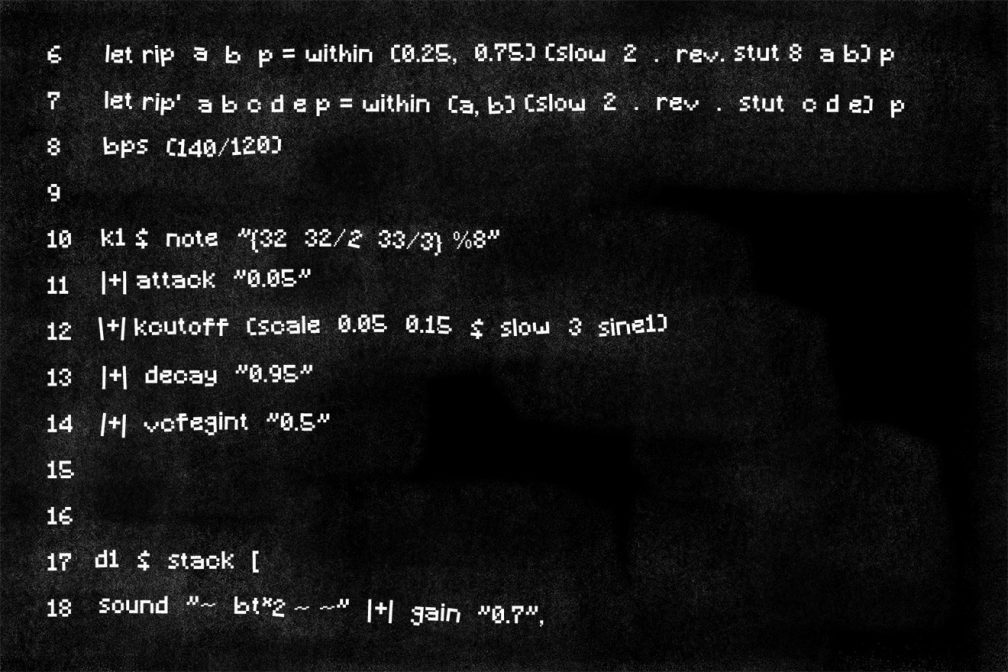 Scene reports
Scene reports
Algorave: The live coding movement that makes next-level electronic music
Artists across the world are redefining what it means to create music with a laptop
In the back room of a bar in the South London suburb of New Cross, there’s a revolution happening. Or maybe it’s not so much a revolution as a de-volution, a rolling back to the backend of music production, where the possibilities of the encoded information inside computer software is open and endless. An artist with the simple stage name Joanne, is standing on a stage at the Amersham Arms, looking at her laptop and typing, immersed in dry ice and the creative process, as a projection plays behind her. Red, blue, green, yellow, purple text on a black background moves and changes; highlighted orange, and cut-and-pasted, in a flash, disappearing with the rhythm of a cursor. The music it conjures is bouncing out of several well-placed speakers. It ricochets from the corners of the dimmed room as a repetitive dull thud drops, then builds up through a crunching, incessant rhythm. Some of the audience squeals, the floor vibrating with a heavy beat that’s almost organic. This is the look and sound of live-coded electronic music, or the more recently (and craftily) coined music ‘genre’ now known as Algorave.
“Suddenly a lot more people started turning up and getting the idea. I think it’s from having a name which doesn't take itself too seriously but sort of gets across the idea that it’s somewhere you go to have fun,” chuckles Alex McLean through video chat, an ‘Algoraver’ himself called yaxu and the organizer of a recent Algorave ‘tour’ through London and Sheffield in England, as well as Karlsruhe in Germany. “Having a kind of identity has helped and, I guess, before there weren’t so many people doing it but through various efforts we’ve broadened the community, it’s become more of a community of practitioners.”
McLean is a 16-year veteran of this kind of live-coding performance, an event where producers – and quite possibly their audience – understand their instruments at the core, where the programming language of real-time audio synthesisers is pared down and revealed to all on a screen with a stark black or white background. “It’s kind of a Luddite’s approach, in a way, because it's stripping back away from graphical user interfaces and just getting back at the underlying text of all the stuff that's happening inside a computer, all it’s elements, and treating the computer like a language machine, or tool.”

When watching or engaging with an Algorave performance, there are a few things of which to take note. As an audience member, essentially what you’re doing is looking at a person looking at their computer with a straight face. It’s an unusual sight to behold. The sound that comes out of that is often something, coarse, lo-fi and erratic. Sometimes the beats can be hard for the inexperienced dancer to follow, oscillating between the fast breakbeats comparable to drum ‘n’ bass, other times evoking straight up four-to-the-floor rhythms. There’s real, visceral experimentation going on here, even if it’s typed out through a certain syntax. It makes one wonder about the patterns that drive both the human brain and a computer processor, where an intuitive approach to music – within genres like drum ‘n’ bass, even footwork, for example – deploys similar results to a process like live-coding, which is literally literal. “It is a strange experience making this stuff because it is so absorbing using the system,” says McLean. “You get completely absorbed in it and people are responding very physically. You're both locked into this sort of very abstract world of language structures, while also being tuned into this very physical response. So when you're mixing these very abstract linguistic structures with this very physical response, there is something very lateralized going on, you have this very spatial reasoning meshing with this very linguistic reasoning.”


